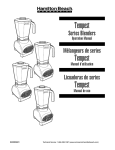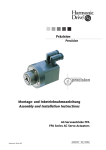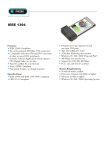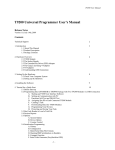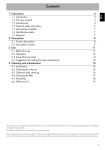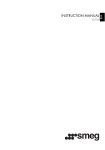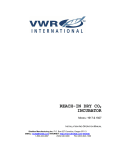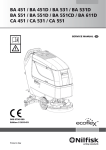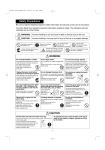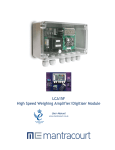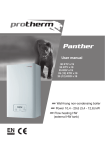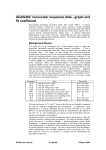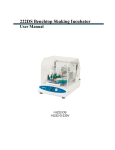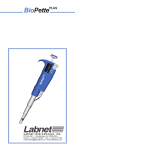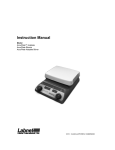Download Model 311 and 611 Laboratory Incubators Manual
Transcript
HIGH PERFORMANCE INCUBATORS MODELS: 311D, 611D INSTALLATION AND INSTRUCTION MANUAL TABLE OF CONTENTS SECTION 1.0 INTRODUCTION SECTION 2.0 WARRANTY SECTION 3.0 SPECIFICATIONS SECTION 4.0 RECEIVING AND INSPECTION SECTION 5.0 INSTALLATION SECTION 6.0 CONTROLS OVERVIEW SECTION 7.0 OPERATION SECTION 8.0 CLEANING AND ROUTINE CARE SECTION 9.0 SERVICE AND TROUBLESHOOTING SECTION 10.0 PARTS LIST WIRE DIAGRAM REV. 3/2005 4861281 These units are high performance incubators for professional, industrial or educational use where the preparation or testing of materials is done at approximately atmospheric pressure and no flammable, volatile or combustible materials are being heated. These units are not intended for hazardous or household locations or use. 2 1 Section INTRODUCTION The Labnet Incubators have been designed for general purpose incubations (<65ºC), as well as those applications requiring higher temperatures (up to 65ºC). Temperature within the incubator is controlled and regulated by a microprocessor. Temperature is set and displayed digitally. An independent, user settable safety thermostat protects samples and the incubator from overheating in the unlikely event of a primary controller failure. A fan, located in the chamber, assists in providing an exceptionally uniform environment. The fan also speeds temperature recovery after the door of the incubator has been opened. For applications where the flow of air in the chamber is undesirable, the fan may be switched off. The interiors of the 311D and 611D incubators are constructed of stainless steel. The exteriors are made of cold rolled steel to resist corrosion and provide strength. The door of the incubator consists of two parts. The inner door is glass to allow for viewing the chamber contents without disrupting the temperature environment. The outer door is solid and insulated. It is also heated to help in maintaining the chamber temperature. The heated door prevents condensation from forming on the inner glass viewing door. Your satisfaction and safety require a complete understanding of this unit. Read this instruction manual thoroughly before attempting to operate the incubator. All operators should be given adequate training before using this incubator. Note that any alterations or modifications to the incubator may void the warranty. Should any questions arise concerning the Labnet Incubators, please call Labnet International’s Customer Service Department at 888 522-6381, Monday through Friday, 8:30am to 5:00pm, EST. 3 2 Section WARRANTY Labnet International, Inc. guarantees that the Model 311/611 Incubator that you have received meets its published specification. The incubator is guaranteed to be free of defects in materials and workmanship for a period of one year from the date of purchase. This guarantee is valid only if the unit has been used in accordance with the instructions in this manual and for its intended purpose. Labnet International, Inc. shall not be responsible for consequential damages or damages resulting from the abuse or misuse of this equipment. Labnet International’s liability shall be limited to the repair or replacement of the unit or refund of the purchase price, at Labnet International’s discretion. For technical service, contact Labnet International’s Service Department at 888 522-6381. Labnet International, Inc. reserves the right to alter the specification of the incubator without notice. This allows the incorporation of improvements as they are developed. Please fill in the following information. This information will be required in the event that service becomes necessary. The serial number is found on the data plate located on the back of the unit. Serial number _______________________ Date of purchase _____________________ 4 3 Section SPECIFICATIONS Temperature Range Temperature Uniformity 311D 611D Temperature Accuracy Temperature Set / Display Temperature Control Overtemperature Safety Interior Outlet Door Chamber Volume 311D 611D Exterior Construction Interior Construction Exterior Dimensions 311D 611D Interior Dimensions 311D 611D Standard Accessories Voltage Requirements Power / Current 311D 611D Ambient +5 to 95C +0.2 @ 37C +0.25 @ 37C +0.2 Digital / digital Microprocessor Independent, settable 1AMP Inner – glass Outer - solid, heated 2.75 cu ft 6.0 cu ft Cold rolled steel Stainless steel 27W x 20D x 29"H 31W x 26D x 34"H 17W x 14D x 20"H 21W x 20D x 25"H Adjustable leveling feet 2 Steel Shelves Shelving Points 120V / 60Hz 800W/6.7A 850W/7.1A 5 4 Section RECEIVING AND INSPECTION 4.1 Inspection: The carrier, when accepting shipment, also accepts responsibility for safe delivery and is liable for loss or damage. On delivery, inspect for visible exterior damage, note and describe on the freight bill any damage found, and enter your claim on the form supplied by the carrier. 4.2 Inspect for concealed loss or damage on the unit itself, both interior and exterior. If any, the carrier will arrange for official inspection to substantiate your claim. 4.3 Return Shipment: Save the shipping crate until you are sure all is well. If for any reason you must return the unit, contact Labnet International, Inc. for authorization and supply the data plate information. 4.4 Accessories: Verify that all of the equipment indicated on the packing slip is included with the unit. Carefully check all packaging before discarding. This unit is equipped with 2 large shelves, 8 shelf clips and 4 leveling feet. If any of these items is missing, contact Labnet International’s Customer Service Department immediately. 6 5 Section INSTALLATION Local city, county, or other ordinances may govern the use of this equipment. If you have any questions about local requirements, please contact the appropriate local agency. Installation may be performed by the end user. Under normal circumstances this unit is intended for use indoors, at room temperatures between 5 and 40C, at no greater than 80% Relative Humidity (at 25C) and with a supply voltage that does not vary by more than 10%. Customer service should be contacted for operating conditions outside of these limits. 5.1 Location: In selecting a location, consider all conditions that might affect performance, such as heat from radiators, ovens, autoclaves, etc. Avoid direct sun, fast-moving air currents, heating/cooling ducts and high-traffic areas. Allow a minimum of 5cm between the unit and walls or partitions that might obstruct free airflow. 5.2 Power Source: Check the data plate for voltage, cycle, phase and ampere requirements. If matched to your power source, plug the power cord into a grounded outlet. VOLTAGE SHOULD NOT VARY MORE THAN 10% FROM THE DATA PLATE RATING. These units are intended for 50/60Hz applications. A separate circuit is recommended to preclude loss of product due to overloading or circuit failure. NOTE: Electrical supply to the unit must conform to all national and local electrical codes. 5.3 Lifting / Handling: These units are heavy and care should be taken to use appropriate lifting devices that are sufficiently rated for these loads. Units should only be lifted from their bottom surfaces. Doors, handles and knobs are not adequate for lifting or stabilization. The unit should be completely restrained from tipping during lifting or transport. All moving parts, such as shelves and trays should be removed and doors need to be positively locked in the closed position during transfer to prevent shifting and damage. 5.4 Leveling: The unit must sit level and solidly. Leveling feet are supplied and must be installed in the four holes in the bottom corners of the unit. With the feet installed and the unit standing upright, each foot can be raised by turning it in a counterclockwise direction. Adjust the foot at each corner until the unit stands level and solid without rocking. If the unit must be moved, turn the leveling feet all the way clockwise to prevent damage while moving. 7 5.5 Cleaning: The unit chamber should be cleaned and disinfected before use. Remove all of the interior parts, and clean thoroughly with a disinfectant that is appropriate to your application. DO NOT use chlorine-based bleaches or abrasives as this will damage the chamber interior. Regular periodic cleaning is required. 8 6 Section CONTROLS OVERVIEW 6.1 Power Switch: The main power ON/OFF switch controls all power to the unit. It must be on before any systems are operational. The green switch will be lighted when ON. 6.2 Main Temperature Control: This control consists of the digital display and Up/Down buttons for inputting set point temperatures and calibration. 6.3 Safety Thermostat: The Safety is completely independent of the Main Controller. The Safety guards against any failure of the Main Controller that would allow temperature to rise past set point. If temperature rises to the safety set point, the Safety takes control of the heating element and allows continued use of the incubator until the problem can be resolved or service can be arranged. 6.4 Fan Switch: This operates the turbo fan inside the chamber for fast heat up times and recovery. The switch is lighted when activated. 6.5 Safety Light: This pilot light comes ON when the Safety Thermostat is activated. Under normal operating conditions this pilot light should never be on. 6.6 Circuit Breaker: The breaker is manually resettable and offers protection against power source variations. Protection is in addition to the automatic high-temperature limit designed into the heating element itself. This is located at the rear of the unit. 9 7 Section OPERATION 7.1 Check power supply against unit serial plate. They must match. 7.2 Plug service cord into the electrical outlet. Push power switch ON, and turn the Safety Thermostat to its maximum position, clockwise. 7.3 Set Main Temperature Control: Enter desired set point temperature. To enter set point mode on the control, press either the Up or Down button one time. The digital display will start to blink, going from bright to dim. While blinking, the digital display is showing the set point. To change the set point, use the Up and Down buttons. If the buttons are not pressed for five (5) seconds, the display will stop blinking and will read the temperature of the unit. Note that the Safety Thermostat should be turned to its maximum position, until the unit has stabilized at desired set point temperature. Allow the incubator at least 24 hours stabilize. 7.4 Calibration: The Main Temperature Controller was calibrated at the factory at 37C; however, it is recommended that calibration is done once the unit is installed in its working environment and has been stable at set point for several hours. Place a certified reference thermometer in the chamber. Be certain the thermometer is not touching any shelving. Allow the temperature to stabilize again until the thermometer reads a constant value for one hour. Compare the digital display with the reference thermometer. If there is an unacceptable difference, put the display into calibration mode by pressing both the Up and Down arrow pads at the same time until the two outside decimal points begin to flash. While the decimal points are flashing the display can be calibrated by pressing the Up or Down arrow pads until the display reads the correct value. Allow the incubator temperature to stabilize again, and recalibrate if necessary. 7.5 Set Safety Thermostat: As mentioned in step 7.3, the Safety Thermostat should be initially set to its maximum position, to allow the unit to stabilize. Once the incubator is stabile at the desired set point, turn the Safety Thermostat counterclockwise until the Safety Light turns on. Next, turn the Thermostat clockwise just until the Safety Light turns off. Then turn the Thermostat clockwise two (2) of its smallest divisions on its scale past the point where the Safety Light went out. This will set the Safety Thermostat at approximately 1oC above main temperature set point. 7.6 Fan Switch: Turn the fan switch on during warm up cycle for faster heat up time. Also, this switch may be used for rapid recovery. Once the unit has reached a 10 stable temperature the fan may be turned off. 11 8 Section CLEANING AND ROUTINE CARE Both the interior and exterior of the incubator should be wiped down with a soft cloth periodically to prevent any build-up of dust and grime. Any spills in the incubator should be cleaned immediately. Cleaning may be performed with a soft, damp cloth. If required, the chamber may be disinfected. Before using any type of disinfectant or cleaning agent in the incubator, check with the product manufacturer to ensure that the product will not damage the stainless steel interior of the incubator. After cleaning the incubator, rinse the cleaned surface with a damp cloth, using water only. Dry with a clean cloth. Do not pour liquid into the chamber or immerse the unit in liquid. DO NOT use chlorinebased bleaches or abrasives as these will damage the stainless steel. 12 9 Section SERVICE AND TROUBLE-SHOOTING TEMPERATURE Temp-1 Temperature too highdisplay and reference thermometer don’t match 1/ Controller failed on – call Customer Service. 2/ Wiring error – call Customer Service. Temp-2 Display reads "HI" or "400"+ Temp-3 Chamber temperature spikes over set point and then settles to set point Temp-4 Temperature too lowdisplay and reference thermometer don’t match Probe is unplugged or broken – Call Customer Service Recalibrate – see section 7.4 13 1/ Safety set too low – see section 7.5. 2/ Controller set too low – see section 7.3. 3/ Unit not recovered from door opening – wait for display to stop changing. 4/ Unit not recovered from power failure or being turned off – incubators will need 24 hours to warm up and stabilize. 5/ Element failure – Call Customer Service 6/ Controller failure – confirm with front panel lights that controller is calling for heat. 7/ Safety failure – confirm with front panel lights that Safety is operating correctly. 8/ Wiring problem – Call Customer Service 9/ Loose connection – call Customer Service. Temp-5 Display reads "LO" 1/ If ambient temperature is lower than range of unit – compare set points and ambient temperature to rated specifications 2/ Sensor is plugged in backwards – call Customer Service. Temp-6 Unit will not heat over a temperature that is below set point 1/ Confirm that fan is moving 2/ Confirm that set point is set high enough Temp-7 Unit will not heat up at all 1/ Do all controller functions work? 2/ Is the Safety set high enough? – for diagnostics, should be fully clockwise with the pilot light never on. 3/ Has the fuse/circuit breaker blown? Temp-8 Indicated chamber temperature unstable 1/ Is fan working? – remove control side body panel and verify movement of cooling fan. 2/ Is ambient radically changing – either door opening or room airflow from heaters or air conditioning ? – stabilize ambient conditions. 3/ Sensor miss-located, damaged or wires may be damaged - check mounts for control and Safety sensors, then trace wires or tubing between sensors and controls. 4/ Calibration sensitivity – call Customer Service. 5/ Safety set too low – be sure that its setting is more than 5 degrees over desired set point; check if pilot light is on continuously; turn controller knob completely clockwise to see if problem solved then follow instructions in section 7.5 for correct setting. 6/ Electrical noise – remove nearby sources of RFI 14 including motors, arcing relays or radio transmitters. 7/ Bad connection on temperature sensor or faulty sensor – check connectors for continuity and mechanical soundness while watching display for erratic behavior; check sensor and wiring for mechanical damage. 8/ Bad connections– check connectors for mechanical soundness and look for corrosion around terminals or signs of arcing or other visible deterioration. Temp-9 Will not maintain set point 1/ Assure that set point is at least 5 degrees over ambient. 2/ See if ambient is fluctuating – check for adjacent open doors or HVAC duct openings, stabilize ambient conditions. Temp-10 Display and reference thermometer don’t match 1/ Calibration error – see section 7.4. 2/ Temperature sensor failure – evaluate if pilot light is operating correctly. 3/ Controller failure – evaluate if pilot light is operating correctly. 4/ Allow at least 24 hours to stabilize at set point temperature. 5/ Verify that reference thermometer is certified. Temp-11 Can't adjust set points or calibration 1/ Turn entire unit off and on to reset. 2/ If repeatedly happens, call Customer Service. Temp-12 Calibrated at one temperature, but not at another This can be a normal condition when operating temperature varies widely. For maximum accuracy, calibration should be done at or as close to the set point temperature as possible. MECHANICAL Mech-1 Door not sealing 1/ Check physical condition of gasket. 2/ Tighten door latch till it pulls glass in. 3/ Assure that gasket is in original location. 4/ Adjust hinge blocks or twist the door. 5/ Confirm that unit has not been damaged and body is square. Mech-2 Motor doesn't move 15 1/ If shaft spins freely: check connections to motor and check voltage to motor. 2/ If shaft rubs or is frozen, relieve binding and retest. Mech-3 Motor makes noise 1/ If noise is from the motor, tap the top of motor shaft with ball peen hammer. Remove back panel to access fan motor. 2/ If the sound gets worse, tap the other end of the shaft – avoiding touching the fan blade. 3/ If there is no change, call Customer Service. 4/ If noise is from shaft or fan blade, realign shaft. 16 OTHER Other-1 Controller on at all times - "locked-up" 1/ Turn unit off and on to reset. 2/ If cannot change any condition on the front panel, call Customer Service. Other-2 Front panel displays are all off Check for wire damage. Other-3 Unit or wall fuse/circuit breaker is blown 1/ Check wall power source. 2/ Compare current draw and compare to specs on data plate. 3/ See what other loads are on the wall circuit. Other-4 Unit will not turn on 1/ Check wall power source. 2/ Check fuse/circuit breaker on unit or in wall. 3/ See if unit is on, e.g., fan or heater, and just controller is off. 4/ Check all wiring connections, especially around the on/off switch. Other-5 Unit is smoking – Out of box This is not an uncommon occurrence when first operating new units. Put unit under vent and run at full power for one hour. – smoking is normal during first cycle to temperature. Other– Contamination in 6 chamber 1/ See cleaning procedure in see section 8.0. 2/ Develop and follow standard operating procedure for specific application; include definition of cleaning technique and maintenance schedule. If following the troubleshooting suggestions does not solve the problem, contact Labnet International’s Service Department at 888 522-6381, Monday through Friday, 9:00am – 5:00pm, EST. 17 PARTS LIST Description Blower Motor Circuit Breaker Convenience Outlet Door Element Door Switch Heating Element Light Socket MP Control On / Off Switch Power Cord Safety Control Safety on Pilot (Green) Turbo Fan Motor 120V 220V I-104100 I-1100505 I-100020 I-100019 I-104103 I-200114 I-104098 I-1750692 I-102025 I-100014 H9200-37 I-102022 I-4880508 I-210001 I-1100505 I-101483 I-100019 I-104103 I-120071 I-104098 I-1750693 I-102025 I-101990 H9200-37 I-2102022 I-4880507 18


















